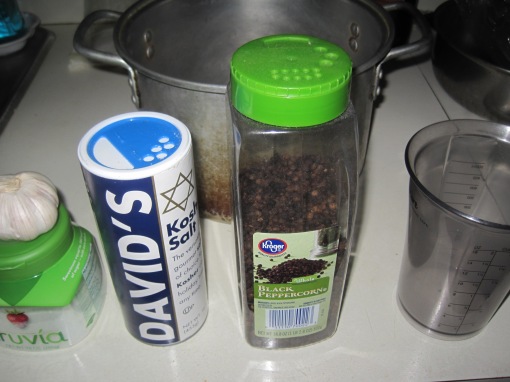I was shopping for meat at the supermarket, and not finding many bargains among the beef offerings. There were some interesting cuts among the pork, though. Hormel had these pork loin roasts for around $5.00, but they were as much as 30% water by weight. I wasn’t interested in buying water at 3-4 dollars a pound. There were also some pork loin roasts though, that had been priced reduced to 3.50 a pound and that sounded interesting. I picked one up.
Looking around for pork loin sous vide recipes, the one I found first was this one, by Dan Gourmet. I will note he brines his meat overnight, and uses maple syrup as his sweetener. I’m diabetic, and I didn’t want to add anything too ridiculously sweet to the meat. Further, I wasn’t wanting to brine overnight, or for that matter, use any potent brining recipes (this one, for example, has a fair amount of negative comment on the web, if you’ll look around. See here, or here). I decided I’d find a simple basic recipe, and work from there.
A generic introduction to brining is this About.com article. This article on CookShack.com talks about brining in the context of smoking meats. (1) More to my purposes, two online resources that are good for simple brining formulas are found on food.com and thekitchn.com. The first resource, from food.com, is a generic brine for multiple meats, useful, for example, in plumping up a chicken. The second reference, from thekitchn.com and Emma Christensen, is a base brine plus some aromatic suggestions.
In terms of aromatics (spices) that might go well with a pork loin roast, a place to start is here.
As a sweetener, my wife has found Truvia to be reliable. With Truvia, 3/4 tablespoon of the product replaces 2 tablespoons of sugar. In terms of aromatics used in pork brines, Dan Gourmet uses peppercorns, and I saw another brine that used 3 cloves of garlic. Those were the aromatics I used. Often when infusing flavors through the brine, you will see recipes that use 1 part hot water (steep the aromatics in these), one part room temperature water, and then two parts ice cubes. (2) I didn’t do anything fancy. I started with cold water, and once my sugar and salt were dissolved, added my aromatics.
So, ultimately, for a pound and a half of pork, I used:
- 1.5 quarts of water.
- 3 tbsp of salt.
- Truvia equivalent to 3 tbsp of sugar.
- 3 cloves of garlic, crushed.
- 1 tbsp of crushed black pepper, from a pepper mill.
A note: When dissolving salt and sugar, use the least amount of water possible to dissolve these two items, and then add the remaining liquid and aromatics.
This was just enough brine to cover the roast. I let the meat soak in the refrigerator for an hour and 45 minutes, and then removed it.
I washed the meat under the faucet, dried it with paper towels, and then chose a couple spices to add to the meat once we bagged it.
Along with thyme (pictured above) I added a bit more crushed black pepper and some onion powder. I made the working assumption that garlic flavor was imparted by the brine. This then was sealed and placed in the fridge for an hour or two, until it became time to cook.
I cooked the meat in a sous vide apparatus at 140 F for 6 hours.

Pork in the pot. Because of the algorithm used by the Auberge to control temperature, the temperature peaks above 140 degrees for a while.
Afterwards, we fished the meat out of the pot. The smell of the meat was fantastic. There are plenty of juices, so if you can follow Stefan Gourmet’s formula for handing sous vide juices, you can make a reduction from this liquid.
The meat itself was essentially white, was flavorful, and was really juicy. The word that comes to mind is amazing. The chunk of meat lasted about 10 minutes. We cut off slices and ate it on the spot. In terms of pleasing just about everyone in my family, this compares to a sous vide buffalo sirloin, and my wife much prefers pork to steak.
Notes:
(1) An important point made in this article is that the combined osmotic effect of both sugar and salt are important in “sugar” brines (i.e. brines that contain sugar). Both the amount of sugar and the amount of salt are important. This was not something I caught onto until after I had made the brine above, and probably affects the ability of Truvia to really replace sugar in a brine.
(2) Indian cooks “break open” spices by pan frying spices in ghee, and I can’t help but wonder if something similar could be done in a non-stick pan with a very minimal amount of oil or cooking spray. That’s an experiment for another time.










